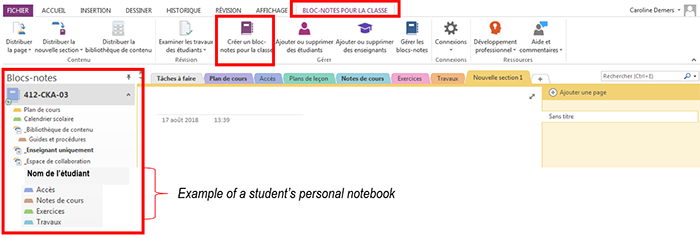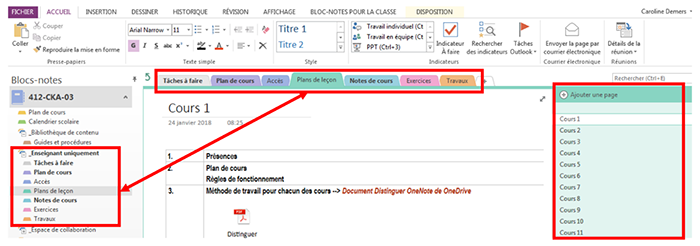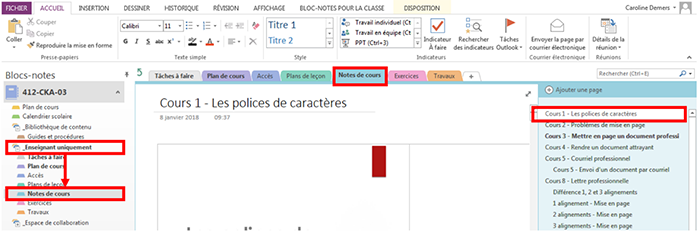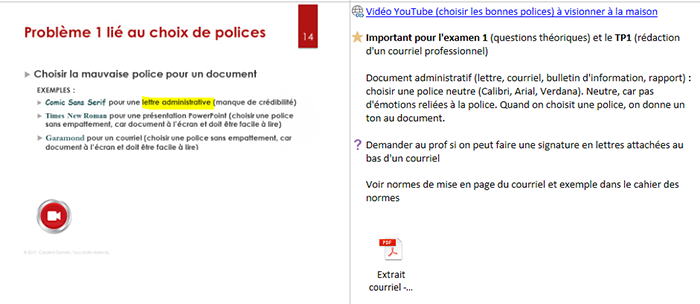OneNote: an Effective Tool for Note Taking, Document Management and Collaborative Work
Microsoft Office OneNote is a very powerful tool for centralizing all documents, resources, and notes of a course or project in one place. Students as well as teachers can thus forego a paper binder and design a virtual binder where they can add and organize the information they have collected on different types of media and platforms (PowerPoint, Word, web sites, screenshots, etc.) and take notes. OneNote eliminates:
- File downloads
- Transferring documents to a USB key or via email
- Managing multiple versions
- Losing information
- Using paper or a Word document for note-taking
If the Microsoft Office suite is installed on the computer, the OneNote software is included automatically. Otherwise, you can use the online version with an Office 365 subscription or the OneNote Online version (free and independent of the Office Suite).
Configuring OneNote for Classroom Use
To use OneNote as part of my course, I had to download the OneNote for Classroom add-in, which was automatically installed in the OneNote software on my computer. This add-in is essential for a teacher to obtain a collaborative environment and share documents with their students. Then, I logged on with my Office 365 Cégep account and I was able to create a private notebook for my class, which was automatically hosted online in the Office 365 cloud. To build my course, I preferred using the OneNote software directly on my laptop because file management was simpler and faster compared to the online application. Since data is continually synchronized, the information is up-to-date in both places.
Upon creating my class notebook, I found 2 sections by default:
- Content Library: The teacher can add and edit documents. Students can only view and copy them to their personal notebook. This is useful, for example, to share additional information such as articles, procedures or guides.
- Collaboration Space: The teacher and students can share and edit documents. This can be useful, for example, when a teacher wants students to provide comments (visible to everyone) on an element to be evaluated or ask them to add relevant resources on a given topic.
As for the Teacher Only section, I had to add it using the Manage Notebooks tab to allow me to have a private area to integrate all the documentation of my course, a personal to-do list, etc.I also added 2 tabs called Lesson Plan and School Calendar and I integrated those documents in PDF format for the students to consult them as soon as they access the class notebook.
Using the Add or Remove Students option, I was able to enter each student’s CEGEP email address that is linked with their Office 365 account, and I sent them an automatic invitation to log in to my class notebook. When each student accepts this request, OneNote creates a personal notebook for them and asks them to add the folder structure that I propose to them. It is not mandatory to provide students with a folder structure, but I strongly recommend it to facilitate the teaching of the course and the software, and to distribute and find files easily and quickly. The student list and their personal notebooks appear at the bottom of the class notebook in the left pane.

Overview of the class notebook
Managing File Distribution
In my private Teacher Only section, to organize the content of my class, I created a classification structure using colour tabs, which are found at the top of the notebook and also in the left pane. Inside each tab, in the right pane, I added pages to integrate the content and take notes.

Overview of the Teacher Only section
Since it is very difficult to retrieve deleted information, it is best to make a backup copy of the class notebook either by copying and pasting it elsewhere in OneNote or by exporting it and saving the file to a computer.
Once all students had joined the class notebook, I was able to start distributing files to them. From the Teacher Only section, I right click on the page I want to distribute to students, I choose the Cross-Notebook Distribution option and I click on the tab in which I want the document to be classified.

Distributing files to students
The teacher can click on each student’s notebook and access it to check, for example, that the distribution of the documents has worked well, to correct information or to provide feedback.


Examples of pages distributed to the students’ personal notebooks from the teacher’s notebook
I prefer to distribute the documents every week and a few days in advance, because there usually is a ten-minute delay before they appear in the student’s personal notebook. When accessing a page in OneNote, students have access to multiple annotation features, for example, to emphasize important concepts in a PowerPoint presentation using the Star tag, or to remember a question to ask their teacher using the question mark tag next to an instruction. Although OneNote is very easy to use, I take the time to teach my students the software in the first class to make the most of the features. It is also important for me to remind students of the lesson plan clause regarding audio recording, since it is forbidden to record the teacher in class.

Annotation options

Example of note-taking in a student’s notebook (teacher’s PowerPoint presentation on the left)
I suggested that my students download the OneNote app on their cell phones (Android and iPhone) to access the notebook without the need for an Internet connection. I also showed them the Send the page by email option in case they want to send their notes to one of their absent classmates.
Integrating OneNote features into learning and assessment activities
In the OneNote for Classroom add-in, the teacher has the opportunity to build tests and formative exercises, share them in the student’s personal notebook, and use the Review Student Work option that compiles the answers received to correct them more quickly. The teacher can also provide them with personalized feedback and copy and paste repetitive comments to save time. On the other hand, this can be a problem for the evaluation of summative exams and assignments because it is important to keep intact the originals deposited by the students. Managing these files is therefore easier with LÉA or Moodle. Students can add their corrected copy to their personal notebook afterwards.
Unlike Moodle, in OneNote, you cannot hide an exam in notebooks or use an automated correction feature. In my classes, I therefore prefer to use OneNote for formative evaluations and Moodle or LÉA for summative evaluations.In the Notepad Information section, each student can share their personal notebook with another person (from the same group or elsewhere) to work collaboratively. You must therefore be careful if you allow the use of personal notebooks during exams.
Using OneNote Effectively
OneNote is an effective tool for being well organized, greatly simplifying information management, and facilitating note taking, collaboration and feedback. To design a simple and easy-to-remember filing system for students in OneNote, it is important to have a clear and complete view of the course, as well as an effective working method for managing information. I recommend you experiment with the class notebook with a fictional student account to anticipate difficulties. To ensure a smooth integration of the software in the classroom, it is best to provide students with a user guide. Video tutorials are also available from Microsoft: What is OneNote?, OneNote for teachers and OneNote for students.

